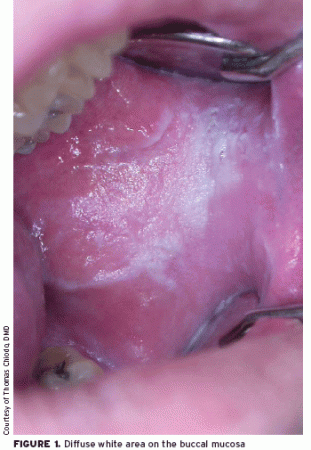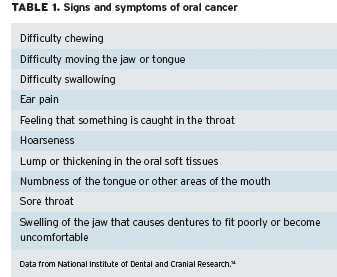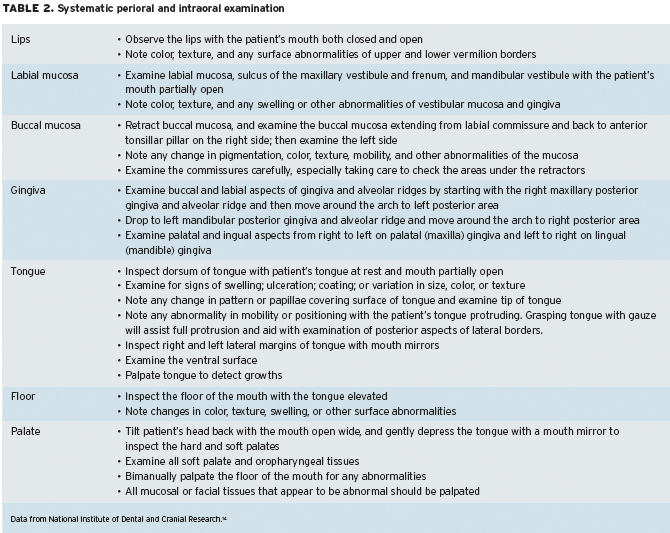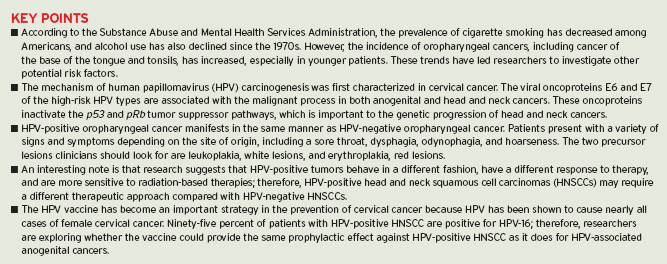Source: www.jaapa.com (Journal of the American Academy of Physician Assistants, October, 2009)
Authors: Denise Rizzolo, PA-C, PhD, Mona Sedrak, PA-C, PhD
Head and neck cancer is diagnosed in approximately 650,000 patients each year worldwide.1 The term head and neck cancer refers to a group of biologically similar cancers originating from the upper aerodigestive tract, including the lip, oral cavity (mouth), nasal cavity, paranasal sinuses, pharynx, and larynx. Oropharyngeal refers to all the structures of the mouth and pharynx, including the tonsils and tongue. Oral squamous cell carcinoma (OSCC) is the most common form of head and neck cancer.2 Seventy-five percent of all OSCCs are attributable to tobacco and alcohol use.3 People who smoke cigarettes are 4 times more likely to develop oral cancer than nonsmokers. Furthermore, individuals who consume alcohol are 3 times more likely than nondrinkers to develop oral cancer.3 According to the Substance Abuse and Mental Health Services Administration, the prevalence of cigarette smoking has decreased among Americans, and alcohol use has also declined since the 1970s.4,5 However despite this, the incidence of oropharyngeal cancers, including cancer of the base of the tongue and tonsils, has increased, especially in younger patients. These trends have led researchers to investigate other potential risk factors.6-8
New studies suggest that there may be an alternative pathway for the development of oropharyngeal cancers. The high-risk types of human papillomavirus (HPV), especially type 16 (HPV-16), are now thought to be potential etiologic agents.2,3 The concept that HPV plays a role in head and neck cancers is not new. This link has been under investigation for at least 20 years.6 This is a worrisome public-health concern because patients with HPV-positive OSCC are 3 to 5 years younger at diagnosis than those with HPV-negative OSCC, and they have a history of high-risk sexual behavior.9-12 Interestingly, patients with HPV-positive OSCC are also less likely to have a history of alcohol and tobacco abuse.3 Therefore, educating patients regarding the disturbing trend of HPV-positive oropharyngeal cancer is important.
Incidence and Prevalence
In the United States alone, an estimated 34,360 people received a diagnosis of oropharyngeal cancer in 2007; of these, 7,550 (5,180 men and 2,370 women) died.13 On average, more than 25% of people who develop oropharyngeal cancer will die of the disease, with only 60% surviving for more than 5 years.14 In fact, oropharyngeal cancer is as common as leukemia and claims more lives than either melanoma or cervical cancer.13
Since the mid 1970s, oropharyngeal cancer rates have increased approximately 15%, with significant disparities in some population groups. For instance, oropharyngeal cancer prevalence is significantly higher in males than in females.14 Prevalence is also higher in Hispanic and black males than it is in white males.14 The risk of oropharyngeal cancer increases with age, and occurrence is highest in persons older than 50 years and peaks between ages 60 and 70 years.14 However, there has been a startling 5-fold increase in the incidence of oral cancer in patients younger than 40 years, many of whom have no known risk factors.4
HPV is associated with 15% to 35% of head and neck cancers worldwide.11 Fifty percent to 90% of OSCCs in the pharynx, tonsil, and tongue are HPV-positive.11 Chaturvedi and colleagues investigated the impact of HPV on the epidemiology of OSCCs in the United States.9 These researchers reported that HPV-positive OSCCs were diagnosed at younger ages than HPV-negative OSCCs (mean age at diagnosis was 61.0 and 63.8 years, respectively) and the incidence increased significantly for HPV-positive OSCC from 1973 to 2004, particularly among younger white men.
Kreimer and colleagues conducted a systematic review of 60 studies and determined that 25.9% of the 5,046 patients with head and neck squamous cell carcinoma (HNSCC) were HPV-positive.2 Furthermore, these researchers noted that HPV-16 was the most prevalent genotype in these cancers, accounting for 86.7% of cases.
Although there is research that supports the association between HPV and oropharyngeal cancers, some studies dispute that relationship. Specifically, controversy exists over the prevalence and significance of HPV in oral tongue cancers (cancer of the anterior two-thirds of the tongue). In a 2008 Mayo Clinic study, researchers examined fresh-frozen tissues from 51 patients with oral tongue cancers.15 Their findings suggest that the incidence of oral HPV in oral tongue cancer was low and was unlikely to play a significant role in the etiology, pathogenesis, and clinical outcomes of oral tongue cancers.15 The authors admit the study was limited by a small sample size and that more research is needed.
Pathogenesis
The oropharyngeal sites that are most often associated with the HPV infection are the tonsils and the tongue.16,17 Reasons why the oropharynx is more susceptible to the HPV infection remain unclear; however, the similarity in accessibility to infection between the tonsillar tissue and the uterine cervical mucosa is believed to make the oropharyngeal area more vulnerable. Another explanation is that tonsillar tissue contains deep invaginations that may capture the virus and facilitate it into the basal cells.
The mechanism of HPV carcinogenesis was first characterized in cervical cancer. Ninety percent of cervical cancer cases are related to HPV infection, predominantly HPV-16 and HPV-18.18 The viral oncoproteins E6 and E7 of the high-risk HPV types are associated with the malignant process in both anogenital and head and neck cancers.17 These oncoproteins inactivate the p53 and pRb tumor suppressor pathways, which is important to the genetic progression of head and neck cancers. HPV infection may therefore represent an alternate but functional pathway for HNSCC pathogenesis. Yet, despite recent literature confirming that HPV is a risk factor associated with oropharyngeal cancers, the HPV infection is not necessary nor is it sufficient for oropharyngeal carcinoma to develop. Therefore, more research is needed to closely define the link between the acquisition of the virus and the progression to cancer.
The major prognostic factors for head and neck cancer are the presence of local and regional metastasis, vascular or lymphatic invasion, positive surgical margins, and extracapsular spread of tumor cells from the lymph nodes into the soft tissue of the head and neck.19 Thus, understanding the mechanism of tumor progression may help to identify new prognostic and predictive markers that will aid in the development of new therapeutic agents for the treatment of HPV-positive cancer.20
Incidence of HPV Transmission
The association between high-risk sexual behavior and transmission of HPV is well-established.10,21 Certain sexual behaviors are associated with a significantly increased risk of HPV transmission, including engaging in casual sex, young age at first intercourse, and infrequent use of condoms. Specifically, a high number of lifetime sex partners (26 or more vaginal-sex partners, 6 or more oral-sex partners) is associated with an increased risk of oropharyngeal cancer. A study conducted from 2000 to 2006 positively correlated HPV-16-positive cancer of the head and neck with number of oral-sex partners, as well as with marijuana use.22

Diffuse white area on the buccal mucosa
The onset of the HIV epidemic has resulted in an increase in oral sex practices among teenagers and young adults, which may be contributing to the increase in the incidence of HPV-positive cancers.23 A common belief among people in these age-groups is that oral sex represents a form of “safe sex,” leading to a worry-free behavior that precludes them from contracting sexually transmitted diseases. These findings emphasize a significant implication to public health. The increase in the incidence of tonsillar and base-of-tongue cancers in the United States may be a result of a higher incidence of oral-sex practices.7,8
Clinical Signs and Symptoms
HPV-positive oropharyngeal cancer manifests in the same manner as HPV-negative oropharyngeal cancer. Therefore, clinicians should be aware of the signs and symptoms that suggest OSCC. Patients present with a variety of signs and symptoms depending on the site of origin, including a sore throat, dysphagia, odynophagia, and hoarseness14 (Table 1). The two precursor lesions clinicians should look for are leukoplakia, white lesions (Figure 1), and erythroplakia, red lesions. Although leukoplakia lesions are more common, erythroplakia and lesions with erythroplakic components have a much greater potential for becoming cancerous. Any white or red lesion that does not resolve within 2 weeks should be reevaluated and considered for biopsy to obtain a definitive diagnosis.14 The following are the four basic steps to early detection and prevention of disease:
• Take a thorough history
• Perform a detailed examination of the head and neck
• Educate patients on the risk factors associated with oral cancers
• Provide adequate follow-up to ensure a definitive diagnosis of any suspicious lesions.14

A thorough history and physical examination of the head and neck should be a routine part of each patient’s general medical examination. Clinicians should be particularly vigilant when examining patients who have a history of tobacco use or drink excessive amounts of alcohol. The examination is conducted with the patient seated. The patient should remove any intraoral prostheses before beginning the examination. The extraoral assessment includes inspection of the face, head, and neck; note any asymmetry or skin pathology, such as crusts, fissuring, growths, and/or color changes. The regional lymph node areas are bilaterally palpated to detect any enlarged nodes.14 The perioral and intraoral examination follows a detailed, seven-step systematic assessment14 (Table 2).

Therapeutics
Recent data suggests a better prognosis for those patients with HPV-positive HNSCC than for those with HPV-negative HNSCC; however, there is still intense debate over this theory.20 Treatment is the same for patients, regardless of whether they have HPV-positive or HPV-negative HNSCC. Traditional therapy for patients with stage I or II head and neck cancer consists of radiation and/or surgery, and prognosis is excellent. Unfortunately, most patients present with stage III or IV disease, and treatment consists of a combination of chemotherapy, radiation, and surgery.20 Survival rates are greatly diminished when the disease is diagnosed at a later stage.
An interesting note is that research suggests that HPV-positive tumors behave in a different fashion, have a different response to therapy, and are more sensitive to radiation-based therapies; therefore, HPV-positive HNSCCs may require a different therapeutic approach compared with HPV-negative HNSCCs.24 Fakhry and colleagues found that patients with HPV-positive HNSCC had better overall and progression-free survival rates than did patients with HPV-negative HNSCC.24 These findings raise the question of whether traditional therapy is the best option for HPV-positive disease. Even when HNSCC is diagnosed early, treatment still consists of removal of the diseased tissue and/or weeks of radiation therapy that may leave some patients disfigured or with permanent negative sequela (dry mouth, loss of taste, alteration of speech patterns, etc). If HPV-positive cancers are more sensitive to traditional therapy, can less aggressive and extensive treatment be used thereby minimizing the side effects of current therapeutic regimens on this subset of patients? The study authors interpret their results cautiously, suggesting that more research is needed on treatment response and subsequent survival patterns of patients with HPV-positive cancers. Until further research is conducted, therapeutic treatment strategies are the same for HPV-positive and HPV-negative HNSCC.24
Patient Education: Prevention and Detection
The best way to prevent oropharyngeal cancer is to avoid tobacco and alcohol use. In addition, regular dental checkups, including an examination of the entire mouth, are essential for early detection of cancerous and precancerous conditions. Red or white lesions often precede the development of oropharyngeal cancer; therefore, if patients notice any new lesions in their mouths, they should have them evaluated by their clinicians. Lesions that do not resolve after 2 weeks should be biopsied. Detection of oropharyngeal carcinoma while the disease is still localized can dramatically increase survival rates. The 5-year survival rate for patients with localized disease at diagnosis is 82%, compared with only 28% for those whose cancer has spread to other parts of the body.14
Clinicians should take the time to educate young patients regarding HPV infection, its correlation to oropharyngeal cancer, and safe-sex practices. Some discussions in the literature suggest that the HPV vaccine could be considered for the prevention of HPV-positive HNSCC.6,10,20 The HPV vaccine has become an important strategy in the prevention of cervical cancer because HPV has been shown to cause nearly all cases of female cervical cancer. Ninety-five percent of patients with HPV-positive HNSCC are positive for HPV-16; therefore, researchers are exploring whether the vaccine could provide the same prophylactic effect against HPV-positive HNSCC as it does for HPV-associated anogenital cancers.25 D’Souza and colleagues argue that a rationale for HPV vaccination in both boys and girls is that oropharyngeal cancers occur in both men and women.10 They also suggest that if the vaccine prevents oral disease as effectively as it prevents cervical disease, a substantial reduction in the incidence of oropharyngeal cancer in vaccinated populations would provide the ultimate evidence of causality. However, no definitive recommendations to use the HPV vaccine to prevent HPV-positive HNSCC have been made.

Conclusion
Cancers of the head and neck are a worldwide concern. The incidence of HPV-related head and neck cancer is increasing. Clinicians should be aware of the risk factors as well as the clinical signs and symptoms of oropharyngeal cancers. The best way to prevent oropharyngeal cancer is to avoid tobacco and alcohol use. However, consistent safe-sex practices are also effective preventive measures because of the strong correlation between HPV infection and oropharyngeal cancers. This association has researchers considering the potential effectiveness of the HPV vaccine in the prevention of HPVpositive head and neck cancers. JAAPA
Authors’ affiliations
Mona Sedrak is an associate professor in the PA program at Seton Hall University, South Orange, New Jersey. Denise Rizzolo works at the Care Station, Springfield, New Jersey, and is faculty assistant professor in the PA program at Seton Hall University. They have indicated no relationships to disclose relating to the content of this article.
References
1. Boyle P, Ferlay J. Cancer incidence and mortality in Europe, 2004. Ann Oncol. 2005;16(3):481-488.
2. Kreimer AR, Clifford GM, Boyle P, Franceschi S. Human papillomavirus types in head and neck squamous cell carcinomas worldwide: a systematic review. Cancer Epidemiol Biomarkers Prev. 2005;14(2):467-475.
3. Mork J, Lie K, Glattre E, et al. Human papillomavirus infection as a risk factor for squamous-cell carcinoma of the head and neck. N Engl J Med. 2001;344(15):1125-1131.
4. Schantz SP, Yu GP. Head and neck cancer incidence trends in young Americans, 1973-1997, with a special analysis for tongue cancer. Arch Otolaryngol Head Neck Surg. 2002;128(3):268-274.
5. Substance Abuse and Mental Health Services Administration. Results from the 2006 National Survey on Drug Use and Health: National Findings. Rockville, MD: Substance Abuse and Mental Health Services Administration, US Dept of Health and Human Services; 2006. DHHS publication SMA 07-4293.
6. Syrjanen S. Human papillomaviruses in head and neck carcinomas. N Engl J Med. 2007;356(19):1993-1995.
7. Frisch M, Hjalgrim H, Jaeger AB, Biggar RJ. Changing patterns of tonsillar squamous cell carcinoma in the United States. Cancer Causes Control. 2000;11(6):489-495.
8. Shiboski CH, Schmidt BL, Jordan RC. Tongue and tonsil carcinoma: increasing trends in the U.S. population ages 20-44 years. Cancer. 2005;103(9):1843-1849.
9. Chaturvedi AK, Engels EA, Anderson WF, Gillison ML. Incidence trends for human papillomavirus-related and -unrelated oral squamous cell carcinomas in the United States. J Clin Oncol. 2008;26(4):612-619.
10. D’Souza G, Kreimer AR, Viscidi R, et al. Case-control study of human papillomavirus and oropharyngeal cancer. N Engl J Med. 2007;356(19):1944-1956.
11. Saraiya M, Kawaoka K. Incidence of human papillomavirus (HPV)-related head and neck cancers in the US from 1998-2003: Pre-HPV vaccine licensure. [ASCO abstract 6003] J Clin Oncol. 2007;25(suppl):299s.
12. Schwartz SM, Daling JR, Doody DR, et al. Oral cancer risk in relation to sexual history and evidence of human papillomavirus infection. J Natl Cancer Inst. 1998;90(21):1626-1636.
13. American Cancer Society. Cancer Facts & Figures 2007. Atlanta, GA: American Cancer Society; 2007.
14. National Institute of Dental and Craniofacial Research. Detecting oral cancer: A guide for health care professionals. NIDCR Web site. http://www.nidcr.nih.gov/.
15. Liang XH, Lewis J, Foote R, et al. Prevalence and significance of human papillomavirus in oral tongue cancer: the Mayo Clinic experience. J Oral Maxillofac Surg. 2008;66(9):1875-1880.
16. Gillison ML, Koch WM, Capone RB, et al. Evidence for a causal association between human papillomavirus and a subset of head and neck cancers. J Natl Cancer Inst. 2000;92(9):709-720.
17. Haddad RI. Human papillomavirus infection and oropharyngeal cancer. Medscape CME Web site. http://cme.medscape.com/viewarticle/559789. Accessed September 4, 2009.
18. Muñoz N, Bosch FX, de Sanjosé S, et al; International Agency for Research on Cancer Multicenter Cervical Cancer Study Group. Epidemiologic classification of human papillomavirus types associated with cervical cancer. N Engl J Med. 2003;348(6):518-527.
19. Forastiere A, Koch W, Trotti A, Sidransky D. Head and neck cancer. N Engl J Med. 2001;345(26):1890-1900.
20. Haddad RI, Shin DM. Recent advances in head and neck cancer. N Engl J Med. 2008;359(11):1143-1154.
21. Gillison ML, Shah KV. Chapter 9: Role of mucosal human papillomavirus in nongenital cancers. J Natl Cancer Inst Monogr. 2003;(31):57-65.
22. Gillison ML, D’Souza G, Westra W, et al. Distinct risk factor profiles for human papillomavirus type 16-positive and human papillomavirus type 16-negative head and neck cancers. J Natl Cancer Inst. 2008;100(6):407-420.
23. Mosher WD, Chandra A, Jones J. Sexual behavior and selected health measures: men and women 15-44 years of age, United States, 2002. Adv Data. 2005;(362):1-55.
24. Fakhry C, Westra WH, Li S, Cmelak A, et al. Improved survival of patients with human papillomavirus—positive head and neck squamous cell carcinoma in a prospective clinical trial. J Natl Cancer Inst. 2008;100(4):261-269.
25. Devaraj K, Gillison ML, Wu TC. Development of HPV vaccines for HPV-associated head and neck squamous cell carcinoma. Crit Rev Oral Biol Med. 2003;14(5):345-362.

Leave A Comment
You must be logged in to post a comment.